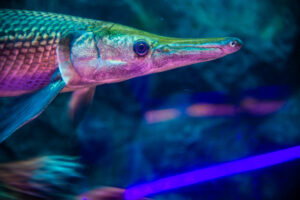
Are you considering keeping an alligator gar? While these fish reach monstrous proportions, they make surprisingly good aquarium species. However, they quickly outgrow their tanks, which means your koi pond might be the only available option for housing. But can alligator gar live with koi?
Alligator gars are large predatory fish that ambush other fish. While koi are not part of their natural diets, alligator gar eat carp, a relative of the koi, and will readily eat any smaller koi they can catch. While keeping alligator gar with koi is not recommended, some workarounds exist.
Alligator gars are the second largest freshwater fish in the US. While most hobby aquarists don’t stray down the uncertain waters of keeping them, some do. Keeping alligator gar provides several interesting challenges, and housing them with koi adds a few more. This article explores compatibility issues (and overlaps), dietary requirements, and alternatives.
Pro Tip: If you’re tired of wasting money and making costly mistakes on the koi-keeping hobby or are thinking about buying koi fish but don’t know where to start, I strongly suggest you check out this ebook. I recently read this ebook, and it contains SO much useful information, such as:
- 3 proven steps to identify koi fish diseases
- WARNING: 3 things you should NEVER do when it comes to caring for koi
- When to seek professional help when it comes to looking after your koi
Alligator Gar And Koi Fish Compatibility Explored
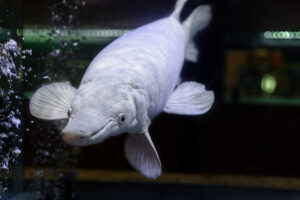
While keeping alligator gar and koi together is not outrightly impossible, it is tricky, and many aquarists don’t recommend it.
Aptly named, alligator gars are massive fish with broad alligator-like snouts filled with sharp teeth. These predatory fish grow to an average of 6 ½’, but monstrous specimens are reputed to reach up to 10′ and weigh 350 lbs! (although the largest on record is 8’5″ and 327 lbs).
Now take your average koi. Most koi are between 12 and 15″, while “jumbo koi” might reach 34 to 36″. While koi are big fish, alligator gars are on a different level, and their size alone is generally a deterrent for most hobby aquarists.
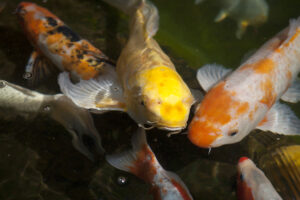
To understand the limitations of alligator gar and koi co-existing in a tank/pond, we’ll explore their habitat needs and feeding behaviors.
If you want to know more about what animals can live with Koi, I recently wrote a few blog posts about this subject that you can read here:
Can Alligator Gar Live In A Pond?
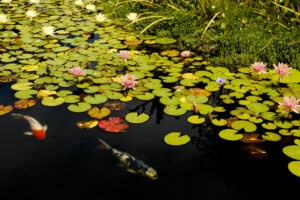
Alligator gar (Atractosteus spatula) are freshwater fish that live in rivers, lakes, marshes, reservoirs, and ponds. Keeping alligator gar in a home pond is possible; however, the pond must be large enough and have sufficient water movement.
Alligator gars breathe air from the pond’s surface. In natural water bodies, wild alligator gars often move into oxygen-starved, semi-still water in search of prey.
In these instances, they swim to the surface, take a breath, and continue hunting. Thanks to a unique swim bladder that acts as a lung, they can survive in these challenging conditions.
Alligator Gar Vs. Koi Habitat Requirements
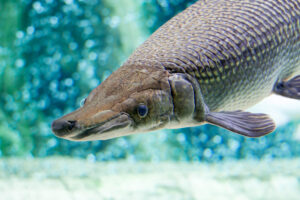
Wild alligator gars inhabit large, wide, slow-moving rivers, oxbow lakes, and bayous (among other areas).
The essential requirement for alligator gar is an adequate-sized pond/tank. These large fish need equally gigantic tanks/ponds. While juveniles may survive in 200 gallons of water, adults require closer to 10 000 gallons.
Koi do not require such tremendous pond sizes. A suitable pond for koi should be roughly 3 feet deep and hold around 1000 gal; this is too small for a fully grown alligator gar. However, alligator gar’s growth rates slow down after their second year, so they’ll be okay in a 1000-gal tank/pond for a few years.
On the other hand, koi can survive in a larger pond, so moving them with the alligator gar as it grows is feasible.
Alligator gars thrive in various water conditions but prefer a temperature range of 59 to 89°F. Koi prefer water that is between 59 and 77°F.
Alligator gar can survive in freshwater and brackish water (high salt content). However, koi need fresh water.
Both species prefer muddy substrates, plenty of vegetation, and submerged logs and rocks. Koi use these obstacles to hide and enjoy foraging in the mud. At the same time, alligator gars remain stationary close to rocks and vegetation in ambush.
Do Alligator Gars Eat Koi?
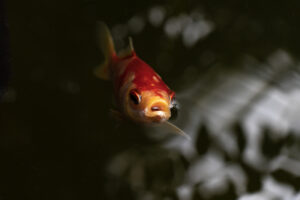
Alligator gar prey predominantly on other (large) fish species, provided they are smaller than the gar (up to 25% of their body length).
I.e., the average 6′ alligator gar could eat a 1 ½’ fish. The average koi grows to roughly 1 to 1 ¼’, making them the ideal size for a hungry gar.
While koi are not part of an alligator gar’s natural diet, popular meals include:
● Buffalo (fish)
● Bass
● Carp
● Crappie
● Shad
Alligator gar may also eat the following:
● Birds (ducks and other waterfowl)
● Crabs and other crustaceans
● Small mammals
● Turtles
Alligator gars are ambush predators, able to remain motionless (often resembling a log). Unsuspecting koi, foraging in the mud, may find themselves snapped up by a hungry gar.
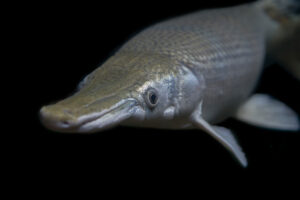
However, larger koi are probably off the hook/menu. Alligator gars ignore larger fish (too big to eat) and are usually peaceful around them.
Whether you can keep koi with an alligator gar depends on the size of the gar and the koi. If your fish are bite-sized, it’s unwise to keep them together.
Would Koi Eat Smaller Alligator Gar?
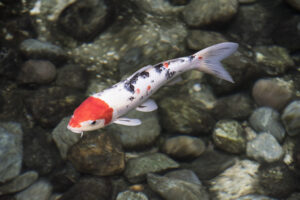
Although koi are peaceful fish, they are opportunistic feeders. They may eat smaller fish of roughly 2 to 4″ (provided the fish fits into their mouths).
Juvenile alligator gars reach 5″ after roughly 1 month, making them too large for most koi.
What Type Of Gar Can I Keep With Koi?

While Alligator gars are challenging, other, smaller gar species are slightly easier to keep with koi.
Keeping Florida Spotted Gar With Koi
Significantly smaller than their monster cousins, the Florida gar (Lepisosteus platyrhincus) grows to around 3′ and feeds predominantly on fish.
The significant benefit of a Florida gar is that its smaller size means its tank/pond requirements are lessened. You’ll need at least 200 gals to comfortably house these gar. However, they’ll be happy in a larger tank/pond (preferably around 400 gals).
While Florida gars also eat fish, crustaceans, amphibians, etc., they are unlikely to eat fish over 3 inches.
Their temperature range is 50 to 85°F, but they do best in 76 to 78°F.
Although these gars are predatory fish, they are generally peaceful and calm toward other (appropriately sized) fish.
Keeping Spotted Gar With Koi
The spotted gar (Lepisosteus oculatus) is similar to the Florida Spotted gar, reaching roughly 3′ and eating (predominantly) fish of up to 3 or 4″.
These gars also prefer slower-moving water (like the streams and marshes of Texas’ backwaters). But requires circulation and filtration.
Spotted gar enjoy tanks/ponds with plenty of vegetation.
Keeping Shortnose Gars With Koi
The shortnose gar (Lepisosteus platostomus) is the other “small” gar species that aquarists might choose instead of an alligator gar.
Shortnose gars also reach roughly 2 to 3′ and prey on smaller fish, insects, and crustaceans.
While these three gars do not reach the same incredulous size as the alligator gars, they are equally fascinating. They would make fantastic additions to a pond/tank.
Conclusion
While keeping alligator gar with koi is possible, most aquarists don’t recommend the practice. Alligator gars are massive and prey on various fish, including carp, a cousin of koi.
Koi need to be big enough that the gar is not interested in trying to eat them (which might mean that the gar is smaller than a fully grown specimen) to keep alligator gar and koi together. Alligator gars also require a lot of space, making them tricky to manage.
Related Blog Posts
Can Crayfish Live With Koi Fish
Everything You Need To Know About The Male Koi
Is It Cruel To Keep Koi Fish? (Yes, And No)
Three Kinds Of Koi Fish Social Behavior
References
https://a-z-animals.com/blog/what-do-alligator-gar-eat/
https://www.floridamuseum.ufl.edu/discover-fish/species-profiles/atractosteus-spatula/#:~:text=Alligator%20gars%20commonly%20grow%20to,ft%20(3m)%20in%20length. https://tpwd.texas.gov/fishboat/fish/management/alligator-gar/unique-fish.phtml#:~:text=Young%20alligator%20gar%20grow%20very,fish%20to%20reach%20larger%20sizes.


